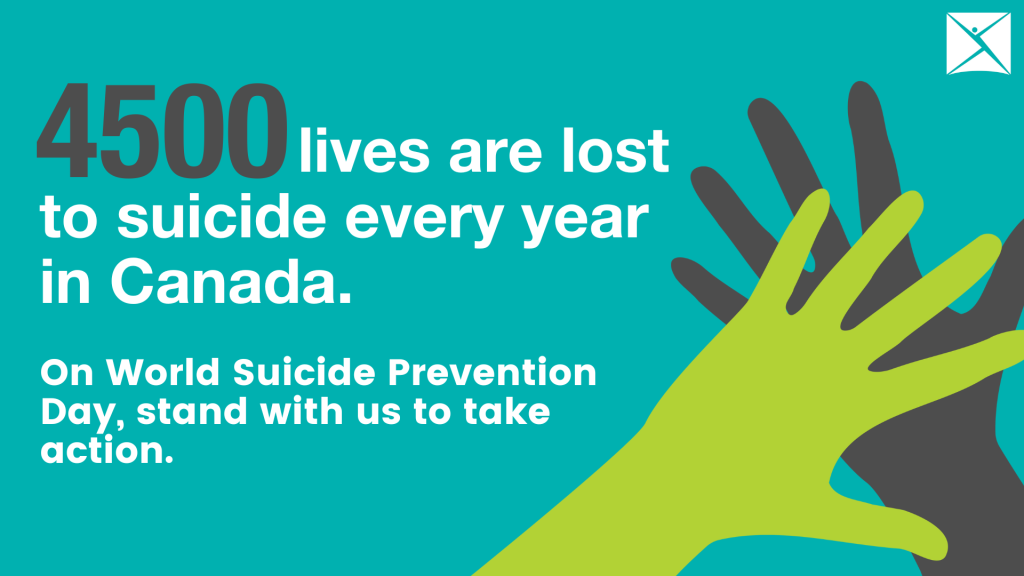Menu
Close

Suicide is preventable. Here’s what we can do.
Sep 6, 2023
By the Canadian Mental Health Association and the Centre for Suicide Prevention
September 10 is World Suicide Prevention Day. Suicide continues to be a crisis in our society, and we are now focusing on it like never before. And with good reason.
- Approximately 4,500 people die by suicide in Canada every year.[i]
- Every year around the world over 700,000 people die by suicide.[ii]
- In fact, in 2019, more than 1 in every 100 deaths (1.3%) were caused by suicide[iii]
The facts are stark, but suicide is preventable. People who think about and attempt suicide don’t want to die: they want a way out of their psychological pain or their deep sense of feeling like a burden.
There’s so much we can do as a society and as individuals to end the suicide crisis.
What we can do as a society
The Government of Canada has taken important action by announcing the launch of a three-digit national suicide and mental health crisis helpline. To be launched at the end of November, the central 3-digit number will make it easier to reach out for urgent help, and we celebrate this!
We know that a central crisis line is the first step. People also need to receive care in their communities after they make the call. The kind of care they need includes mobile crisis response teams, crisis stabilization beds, suicide respite, peer support, referrals to housing, food and income supports, and counselling among other community-based programs and services.
“Care after the Call”
The Canadian Mental Health Association (CMHA) is calling on the federal government to create a “Care after the Call” Fund for crisis prevention and response services in communities. When community-based services are adequately funded, people are able to get the care they need, when they need it, without adding strain on emergency departments.
What you can do as an individual
Support “Care after the Call”
We will be launching a campaign for the “Care after the Call” Fund this fall. Get on board by signing up here.
If you’re concerned about someone, know that you can help. Here are some steps you can take.
1. Pay attention.
Any noticeable change in someone’s behaviour is a warning sign that they might not be doing well. This includes:
- Not texting or calling as much
- Drinking or smoking more than usual
- Appearing tired or distant
- Talking about how much life sucks
- Being more irritable or angry
2. Talk about it. Start a conversation.
Having a caring conversation gives a person the chance to talk, making it less likely that they will carry through with suicide.[iv] Create a safe, open, and non-judgmental environment to have a conversation with the person you care about. For example:
- Over the phone
- While driving in the car
- Over food or drinks at a favourite hang out
- While working on a project
- Mention what you’ve noticed; be specific: “I haven’t heard from you much these days. Is everything okay?”
3. Keep the conversation going.
- Ask questions and listen to what the person is saying.
- Resist the urge to offer solutions.
- Support them. Acknowledge their feelings are valid and let them know that you’re there to support them: “That sounds really hard. But thank you for telling me. Can you tell me more about it? I’m here for you.”
4. Stick to your role.
- You might be a friend, a family member, co-worker, or even a stranger. But whatever role you play, remember that you’re not the person’s counsellor.
- Who else have they told? Encourage them to reach out to others.
5. Still worried? Ask directly: “Are you thinking about suicide?”
- If they say yes, don’t panic.
- Let them know you are there for them and connect them with readily accessible mental health supports.
- Call the crisis line together; call Talk Suicide Canada at 1-833-456-4566. In Québec, call 1-866-277-3553 or visit www.suicide.ca for support by text and online chat.
- If they have immediate plans to die, call 911 and ensure they are not left alone.
Please remember that you can help someone in distress. Suicide can be prevented.
If you are thinking about suicide yourself, there is hope and there is help.
- Please call Talk Suicide at 1-833-456-4566 anytime or text 45645 4PM-midnight ET.
- For residents of Québec, call 1-866-277-3553 or visit www.suicide.ca for support by text and online chat.
The 3-digit line will launch November 30.
[i] Public Health Agency of Canada. (2023). Suicide in Canada: Key statistics. https://www.canada.ca/content/dam/phac-aspc/documents/services/publications/healthy-living/suicide-canada-key-statistics-infographic/ENG.pdf
[ii] World Health Organization. (2021a). Live life: an implementation guide for suicide prevention in countries. https://www.who.int/publications/i/item/9789240026629
[iii] World Health Organization. (2021b). Suicide worldwide in 2019: Global Health Estimates. https://www.who.int/publications/i/item/9789240026643
[iv] Eynan, R., Bergmans, Y., Antony, J., Cutcliffe, J. R., Harder, H. G., Ambreen, M., Balderson, K., & Links, P. S. (2014). The effects of suicide ideation assessments on urges to self-harm and suicide. Crisis, 35(2), 123-131. https://doi.org/10.1027/0227-5910/a000233
Reynolds, S. K., Lindenboim, N., Comtois, K. A., Murray, A., & Linehan, M. (2006). Risky Assessments: Participant Suicidality and Distress Associated with Research Assessments in a Treatment Study of Suicidal Behavior. Suicide and Life-Threatening Behavior, 36, 19-34. https://doi.org/10.1521/suli.2006.36.1.19
Deisenhammer, E. A., Ing, C., Strauss, R., Kemmler, G., Hinterhuber, H., Weiss, E. M. (2009). The duration of the suicidal process: how much time is left for intervention between consideration and accomplishment of a suicide attempt? Journal of Clinical Psychiatry, 70(1), 19-24. https://doi.org/10.4088/JCP.07M03904
